The map below shows all of the locations at which we stopped overnight. If you click on one of the place marks, more information (distance, engine hours, anchor chain) will pop up.
View Cruise 2014 in a larger map
The map below shows all of the locations at which we stopped overnight. If you click on one of the place marks, more information (distance, engine hours, anchor chain) will pop up.
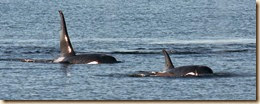 After passing the last of the rapids, Yuculta, that separate the Broughtons from the Desolation Sound area, we were anxious to get across the Strait of Georgia. We went first to Cortes Bay, then traveled down Malaspina Strait on the east side of Texada Island to Pender Harbour. From there we headed across the Strait of Georgia but not before encountering a pod of a half dozen orca near Thormanby Island. We entered the Canadian Gulf Islands via Porlier Pass, anchoring for the night on the north side of Gray Peninsula by Montague Harbour.
After passing the last of the rapids, Yuculta, that separate the Broughtons from the Desolation Sound area, we were anxious to get across the Strait of Georgia. We went first to Cortes Bay, then traveled down Malaspina Strait on the east side of Texada Island to Pender Harbour. From there we headed across the Strait of Georgia but not before encountering a pod of a half dozen orca near Thormanby Island. We entered the Canadian Gulf Islands via Porlier Pass, anchoring for the night on the north side of Gray Peninsula by Montague Harbour.
Other than strong opposing currents in the Boundary Pass area, crossing the border was straightforward. Our first port of call was Deer Harbor Marina where our yacht club has dock space. The only other club boat there was Sea’s the Moment owned by Chris and Sandy Benson who winter moor in Winslow directly ahead of us on the dock. We spent our first evening back gabbing for several hours with them catching up on travels.
Some winds were forecast on the Strait of Juan de Fuca the next day so we spent a second night at the dock. An early start on Tuesday, September 9, got us across the strait in time to catch the start of the flood current down Admiralty Inlet. We wanted to add some fuel in our tanks to get us through the winter so we headed to Poulsbo for the night with the intent to go to the fuel dock first thing the next morning. We took advantage of the reciprocal dock at the lovely Poulsbo Yacht Club marina for our nights moorage.
After taking on 300 gallons of diesel at the Poulsbo fuel dock, we headed to our winter spot on the dock in Eagle Harbor. We arrived at 1130 on September 10, 20 weeks after departing on April 23.
During the 140 nights we were away, we anchored out 86 nights, moored at public docks (i.e., no services) 7 nights, and paid for moorage 47 nights. Using my navigation program’s trip log as the arbiter, we covered 4052 nautical miles during that time. Our main engine operated 720.8 hours including 48.5 hours spent at idle fishing or taking photographs. Subtracting those idling hours, we averaged 6.03 nm/hour which is our normal speed. This average speed includes the time spent anchoring and docking at the begin and end of each day’s travels. Fuel economy calculations will have to wait until next Spring when we fill up ahead of our trip north.
The fog lay thick the morning of August 12 as we departed Fury Cove and it remained thick for next nine hours. Electronic charting, radar and AIS were how we navigated and avoided other vessel traffic in the less that 1/4 mile visibility. We put the stabilizers in the water less than an hour after we left the anchorage. With the visibility as poor as it was, we didn’t want to have to worry about sea conditions on top of our other concerns. The anchorage for the night was Carriden Bay, about 68 miles from our starting point.
While in Alaska, we arranged for my brother Mike and his wife Jo to join us in Port McNeill for a weeks worth of cruising later in the month so we had some major inside & outside boat cleaning to do before their arrival. In addition, we wanted to insure that some of the destinations we were going to take them still had the prawns we were promising them.
After visiting Sullivan Bay Marina, we headed to Port McNeill for fresh water, provisioning and the first round of cleaning. While there we crossed paths with Doug and Cathlyn MacQuarrie from our yacht club. In 2012, we sublet the slip at Shilshole Marina where they live on their Nordhavn 46. They offered some suggested destinations in the Broughtons that we had not visited before.
The cruising in the Broughton archipelago is far more intimate than what you encounter in Alaska. The channels between the many islands are numerous, intricate and well protected from the outside waters. In addition, there are a half dozen or so small family operated marinas catering to pleasure craft. They provide an opportunity to socialize with other boats at the organized evening happy hours or dinners. During the three weeks we were in the area, we stopped at Shawl Bay, Sullivan Bay, Echo Bay, Kwatsi Bay and Port Harvey. We also stopped at the docks of the closed Greenway Sound Marina. The docks are showing the wear of several years without maintenance and we chose to anchor in the cove behind Broughton Point on our subsequent visits to Greenway Sound.

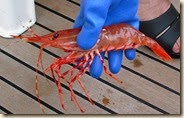 We had regaled Mike & Jo with the bounty we had pulled from the waters on our cruise so we were determined to produce while they cruised with us. The prawn gods were smiling on us and we were able to feature prawns several nights.
We had regaled Mike & Jo with the bounty we had pulled from the waters on our cruise so we were determined to produce while they cruised with us. The prawn gods were smiling on us and we were able to feature prawns several nights.
After Mike & Jo left us, we made one more pass through the Broughtons then headed south. We elected to take eastmost route which necessitates timing five rapids, Whirlpool, Green, Dent, Gillard & Yuculta. We hadn’t been this way since our 2007 trip in our first boat. We split the rapids in two by stopping for the night at Cordero Lodge which is a few miles after passing Green Rapids.
In contrast to the rainy Alaskan weather we experienced June and July, the three weeks we spent in the Broughtons were almost uniformly sunny. According to the marina operators, they had only a few days of rainy weather all summer. We made a conscious effort to try new places, anchoring in five new locations, and found several new spots for prawn fishing.
From Fredrick Sound we head into Petersburg for a few days to provision. Arriving on Thursday, July 24, our stay was originally to be two days but we stretched it into three when heard the windy forecast in Sumner and Clarence Straits through which we had to travel. A very stable low was sitting in the Gulf of Alaska and it would send periodic waves of rainy and windy weather through SE Alaska, especially the southern portions.
We transited through Wrangell Narrows in mist interspersed by rain showers the afternoon of 7/27 and headed to St John Harbor, directly across Sumner Strait from Wrangell Narrows.
The next morning, after reading the weather report we downloaded via the satphone, we chose to avoid the northern section of Clarence Strait and head down Zimovia Strait and use Ernest Sound to join Clarence Strait only 30 miles north of Ketchikan. Santa Anna Inlet was our anchorage for 7/28.
On the morning of Tuesday, 7/29, we headed for Meyers Chuck, a small Alaskan community at the NW corner of the Cleveland Peninsula, right where Ernest Sound meets Clarence Strait. The forecast we downloaded, updated as of 0648, said Clarence was SE20 knots going to SE15 in the afternoon with 4 foot seas. No problem, we thought as we were only traveling 2 or 3 miles in Clarence before entering the protected cove of Meyers Chuck.
As we approached the area where Ernest Sound met Clarence Strait, the forecasted E10-15 winds of Ernest Sound gave way to first SE20-25 and then SE30+, the seas began to build and our forward speed dropped from 6+ knots (our typical plodding pace) to 3+ knots on account of the head seas we were pounding through.
After 45 minutes of nerve wracking pounding followed by and an even more nerve wracking 120 degree turn in order to line up with the entrance to Meyers Chuck, we rode the following seas through the narrow entrance. The salon was a bit of a mess as books came crashing out of the book case during the rolling we did while executing the turn. After anchoring, we listened to the weather radio and found out that the weather service had issued a 0940 update which changed the Clarence Strait forecast to SE30 knots with 50 knot gusts and 6 foot seas, going to SE20 in the afternoon. In 2011 Clarence Strait beat us up pretty good and it did it again this year.
The next day, the forecast and reality agreed on a pretty nice day, and we arrived in Ketchikan mid-morning on July 30. After our weather experiences of the previous week, we decided get into British Columbia ASAP and we did lots of chores in order to leave the next morning.
July 31 was a beautiful day, we thought the Alaskan weather gods were trying to persuade us to stay a bit longer but we weren't buying its story. We dropped anchor in Foggy Bay, one of the last good anchorages before crossing Dixon Entrance into Canada.
August 1 we headed into Prince Rupert in order to clear customs and immigration. We stayed at the Prince Rupert Rowing & Yacht Club, probably the most accommodating moorage in the town to transient pleasure craft. It is also convenient to shopping for those forbidden items (most fruits and many vegetables) or customs limited items (beer & wine).
After a lovely night at anchor in Lowe Inlet on August 2, the morning of August 3 we continued down Grenville Channel to do some fishing around Gil Island. After an 1-1/2 hours of trolling, Marcia had one silver and one king salmon and we headed to Cameron Cove for the night.
The next day, August 4, we tried trolling around the south end of Gil Island, a few nibbles but no takers. There was lots of humpback whale activity in the area so that provided some amusement. We also had one near collision with a whale who decided to take a nap (or at least a facsimile of one) on the route to our anchorage. I was pretty close when I noticed this grey mound in the water was neither a wave nor an uncharted rock. I maneuvered around him but he was not alarmed and remained there drifting along. Our Hawk Bay anchorage on Fin Island was only a short distance away.
On August 5, we had the first rain showers since our Clarence Strait experience, a week earlier. That didn't dissuade Marcia from putting her hooks in the water around Gil Island one more time. After 2 hours we were ready to throw in the towel when a beautiful 27" silver salmon took the bait. The rainy weather was a blessing because we travelled nearly 60 miles to Bottleneck Inlet with the fish in a cooler filled with cold water before Marcia got her chance to clean the fish when we anchored.
We headed down Finlayson Channel in a thick fog the morning of August 6 but it burned off as we rounded Ivory Island into Seaforth Channel. The wind was picking up so we didn't fish Idol Point. We tried a new (to us) anchorage in Troup Narrows.
The winds were calm the morning of August 7 as we headed back out to Idol Point. Lots of trolling but no fish was caught. We did see and greet a vessel of another member of our yacht club who was also fishing the area. We hoped to spend the night at the dock in Shearwater but they were fully booked so we dropped the anchor in a satisfactory but not exciting anchorage, Bob Bay.
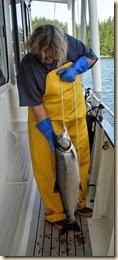 The weather and winds were pretty mellow on August 8 as we cruised Fitz Hugh Sound southbound to fish along Hakai Passage. Our dock neighbors in Eagle Harbor on Bainbridge Island spoke highly of the area. We first tried the north side where 10 or so boats from nearby fishing lodges were fishing. After one pass and no action, we crossed over the the south side. After a half hour or so and right outside the entrance to our anchorage, Marcia hooked and landed a 29" silver salmon.
The weather and winds were pretty mellow on August 8 as we cruised Fitz Hugh Sound southbound to fish along Hakai Passage. Our dock neighbors in Eagle Harbor on Bainbridge Island spoke highly of the area. We first tried the north side where 10 or so boats from nearby fishing lodges were fishing. After one pass and no action, we crossed over the the south side. After a half hour or so and right outside the entrance to our anchorage, Marcia hooked and landed a 29" silver salmon.
 The next morning, August 9, we started early for the morning bite. It took a little over an hour of trolling but in nearly the same spot as the night before, Marcia landed a 28" silver salmon. Since the freezer is getting full, we headed to our anchorage in Pruth Bay. That afternoon we paddled our kayaks to the beach at the head of the bay and walked the trail over to the lovely sandy beach that looks out onto the ocean. For dinner that night Marcia grilled on a cedar plank some of the salmon she had recently caught.
The next morning, August 9, we started early for the morning bite. It took a little over an hour of trolling but in nearly the same spot as the night before, Marcia landed a 28" silver salmon. Since the freezer is getting full, we headed to our anchorage in Pruth Bay. That afternoon we paddled our kayaks to the beach at the head of the bay and walked the trail over to the lovely sandy beach that looks out onto the ocean. For dinner that night Marcia grilled on a cedar plank some of the salmon she had recently caught.
The sunny weather continued the next day, August 10, as we crossed Fitz Hugh to explore Fish Egg Inlet. We worked our way towards its end and anchored the night in Oyster Bay. It is totally landlocked with trees down to the high tide line, a very different feel from Pruth Bay which, while protected from ocean surf still has an outer coast feel.
With a favorable forecast for the next day, on August 11 we drop the anchor in Fury Cove, a lovely anchorage and conveniently located for rounding Cape Caution. There are already four boats here but before the day ends, another six follow bringing the total to eleven boats (including ourselves).
For cruising in SE Alaska, Glacier Bay is the furthest north without taking the major commitment to poke your nose a ways out into the Gulf of Alaska. We've not felt the calling to do so and we use Glacier Bay as our turn around point for our cruising season.
After we said good bye to Marcia's sister and brother-in-law at Bartlett Cove on July 6, we first visited Excursion Inlet, about 30 miles away but still technically in the park. It turned out to be a real treat, a lovely anchorage that we had to ourselves. From there we did a little fishing (two too small salmon) along the route to Swanson Harbor. The rain found us there and followed us the rest of the way to Sitka (with an overnight stop at Appleton Cove) on July 9.
While in Sitka we met up with Wade Biggs (“Honu”) and David Cohn (“Shearwater”). David has a Seahorse Marine Diesel Duck (a cousin ship to ours). David brought the boat back from the factory in China on its bottom in 2013. Wade crewed for David on that trip. Wade and David buddy-boated from Puget Sound having left in early June.
The SE Alaska weather this summer has been generally wetter the normal. For the month of June, both Sitka and Ketchikan had about twice the normal precipitation. The fact that last year, 2013, was below normal precipitation and above normal temperature makes the contrast even more stark. The table below shows the June monthly precipitation for a “normal” year and in the last three years. We weren’t here in 2012 but when we were here in 2013, everybody talked about 2012 as the “summer that never was”.
| Normal | 2014 | 2013 | 2012 | |
| Sitka | 2.89 | 5.95 | 2.44 | 4.47 |
| Ketchikan | 6.60 | 12.25 | 4.65 | 9.85 |
When we saw a window of nice weather, we headed out on July 14 for some cruising south of Sitka. We stayed at two new (to us, anyway) anchorages, Presidents Bay and Leesoffskaia Bay and one tried & true anchorage, Scow Bay. Despite our best efforts, the fish eluded Marcia's fish hook. We returned to Sitka on Thursday, July 17.
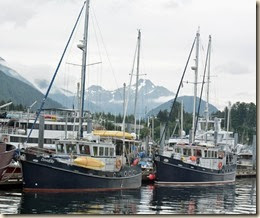 On Friday, we enjoyed a visit with Wade, David and Dave & Dorothy Nagle, who arrived on their Seahorse Marine Diesel Duck, "DavidEllis." Dave Nagle also crewed on "Shearwater" for the Hong Kong to Hawaii leg of the crossing.
On Friday, we enjoyed a visit with Wade, David and Dave & Dorothy Nagle, who arrived on their Seahorse Marine Diesel Duck, "DavidEllis." Dave Nagle also crewed on "Shearwater" for the Hong Kong to Hawaii leg of the crossing.
We took off Saturday, 7/19, for the next leg south. Since the weather forecast suggested continued marginal weather, we elected to do a conservative protected water route over to Petersburg rather than a more open water route along the outside.
While we have no firm data, it seems like there are a more boats cruising SE Alaska this year than last. Certainly it felt that way when we started towards Douglass Bay in Hoonah Sound after leaving Sitka and we saw five more boats behind us. Since we are always the slowest boat in the "parade," we knew we would be the last to arrive. We made a quick decision and changed our destination for the night to Pt. Moses Cove in Hanus Bay on the north side of Baranof Island. We ended up sharing that with one other boat.
On 7/20, we started off with the intent to reach Red Bluff Bay. Partway down Chatham Strait, the light winds we had been experiencing increased to S15-20 knots with short choppy waves all on the nose. While the conditions were perfectly safe, they weren't pleasant. We again made the quick decision to change our destination to Takatz Bay, a five-star anchorage.
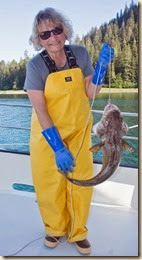 The next day, 7/21, the winds were light again and we headed into Frederick Sound with a stop along the way at Pt Gardner at the SW corner of Admiralty Island for some fishing. Despite our timing the stop for slack currents, they seemed to running at least one knot which made fishing for halibut challenging. No halibut grabbed the hook but Marcia landed a nice 30 inch Pacific Cod.
The next day, 7/21, the winds were light again and we headed into Frederick Sound with a stop along the way at Pt Gardner at the SW corner of Admiralty Island for some fishing. Despite our timing the stop for slack currents, they seemed to running at least one knot which made fishing for halibut challenging. No halibut grabbed the hook but Marcia landed a nice 30 inch Pacific Cod.
With fish in hand we headed into Cannery Cove in Pybus Bay on the SE corner of Admiralty Island. We had been texting with some folks from our yacht club also cruising in SE Alaska. We coordinated a rendezvous with Craig & Ann Wilbour ("Shot-8") and spent the evening sharing our cruises to date and plans for the remainder.
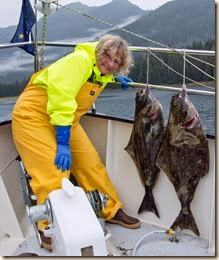 On 7/22, we used Cannery Cove as a base for a fishing trip out into Frederick Sound. Marcia identified a likely area for halibut and after a couple of hours effort had two nice halibut (32" & 34") to show for it. Back to Cannery Cove we went where Marcia spent the afternoon processing her catch. Despite only a vague hint of precipitation, a steady rain hovered over our anchorage for the afternoon giving the boat and Marcia a fresh water rinse.
On 7/22, we used Cannery Cove as a base for a fishing trip out into Frederick Sound. Marcia identified a likely area for halibut and after a couple of hours effort had two nice halibut (32" & 34") to show for it. Back to Cannery Cove we went where Marcia spent the afternoon processing her catch. Despite only a vague hint of precipitation, a steady rain hovered over our anchorage for the afternoon giving the boat and Marcia a fresh water rinse.
We like to arrive in Petersburg at high slack because the currents that speed through the docks there are minimized. We’ve had enough near docking mishaps in Petersurg that we want as many of the controllable elements working for us. To get the right timing, we split the journey to Petersburg up and anchored the night of July 23 at Ruth Island Cove in Thomas Bay.
A leisurely start on July 24 got us into Petersburg at high tide and with the currents modest. The forecast is for the winds and seas to kick up for the next few days so we may take a few days off from travelling.
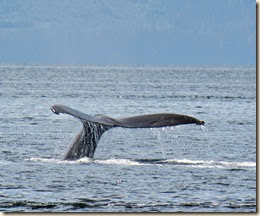 Joining us for the next leg of our 2014 cruise was Marcia's sister Cindee and her husband Steve. Steve is an accomplished nature photographer but had not yet visited Glacier Bay National Park. In order to give him the greatest opportunity to capture images in the best light, we agreed that spending the entire 2-weeks of their visit with us in Glacier Bay made the most sense. Since the NPS only issues permits for a maximum of 7-days at a time, it took some effort (mainly by Steve) to obtain two permits back-to-back (the NPS allows vessel operators to have two permits at a time).
Joining us for the next leg of our 2014 cruise was Marcia's sister Cindee and her husband Steve. Steve is an accomplished nature photographer but had not yet visited Glacier Bay National Park. In order to give him the greatest opportunity to capture images in the best light, we agreed that spending the entire 2-weeks of their visit with us in Glacier Bay made the most sense. Since the NPS only issues permits for a maximum of 7-days at a time, it took some effort (mainly by Steve) to obtain two permits back-to-back (the NPS allows vessel operators to have two permits at a time).  To maximize their time, Cindee & Steve flew directly into Gustavus, a 9-mile shuttle ride to Bartlett Cove, the NPS Glacier Bay Headquarters. We agreed to meet them in Bartlett Cove at the public dock.
To maximize their time, Cindee & Steve flew directly into Gustavus, a 9-mile shuttle ride to Bartlett Cove, the NPS Glacier Bay Headquarters. We agreed to meet them in Bartlett Cove at the public dock.  All of the logistics worked fine and we arrived the morning of June 22 at the dock about the same time as their ride from Gustavus dropped them off. Alaska's "finest" weather (i.e., rain) welcomed them to Glacier Bay. After we attended the boater orientation, we tanked up on water and discarded our garbage and recyclable material and took off for our first night's destination.
All of the logistics worked fine and we arrived the morning of June 22 at the dock about the same time as their ride from Gustavus dropped them off. Alaska's "finest" weather (i.e., rain) welcomed them to Glacier Bay. After we attended the boater orientation, we tanked up on water and discarded our garbage and recyclable material and took off for our first night's destination. 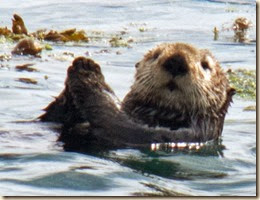 Since we had the time, we worked hard at seeing as much of the park as possible from a boat. We covered over 400 miles cruising through the various bays and inlets, used 8 different anchorages (2 of which were new to us). We saw bear (brown and black), moose, mountain goat, wolf, river otter, sea otter (lots), stellar sea lion (lots), puffin, orca and humpback.
Since we had the time, we worked hard at seeing as much of the park as possible from a boat. We covered over 400 miles cruising through the various bays and inlets, used 8 different anchorages (2 of which were new to us). We saw bear (brown and black), moose, mountain goat, wolf, river otter, sea otter (lots), stellar sea lion (lots), puffin, orca and humpback. 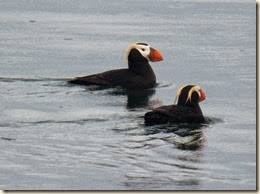 The best whale viewing was in the Bartlett Cove anchorage, arguably the most developed part of the park. Both orca and humpback whales cruised by within 50 yards of our boat.
The best whale viewing was in the Bartlett Cove anchorage, arguably the most developed part of the park. Both orca and humpback whales cruised by within 50 yards of our boat. 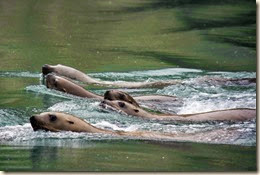 The weather was okay but often cloudy and moist. Fortunately, the winds were generally light to moderate (i.e., less than 10 knots).
The weather was okay but often cloudy and moist. Fortunately, the winds were generally light to moderate (i.e., less than 10 knots). 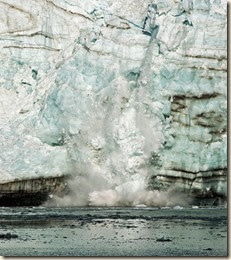 The best weather day was the day we went to the head of Tarr Inlet where the tidewater Margerie Glacier terminates. We stayed the night before in Reid Inlet about 12 miles south so our early start put us at the glacier before the cruise ships, tour boats and other pleasure craft arrived. It is a special treat to drift in the water a quarter-mile off from the face of a cracking and rumbling glacier. The occasional ice fall from the glacier to the water and subsequent wake persuaded us to move a little further out where we drifted with engine off to fully appreciate the setting.
The best weather day was the day we went to the head of Tarr Inlet where the tidewater Margerie Glacier terminates. We stayed the night before in Reid Inlet about 12 miles south so our early start put us at the glacier before the cruise ships, tour boats and other pleasure craft arrived. It is a special treat to drift in the water a quarter-mile off from the face of a cracking and rumbling glacier. The occasional ice fall from the glacier to the water and subsequent wake persuaded us to move a little further out where we drifted with engine off to fully appreciate the setting. 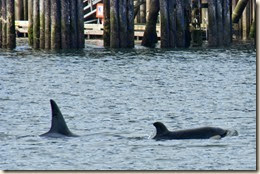 The two permits were separated by a day in which we anchored in Bartlett Cove. We used that time to walk the trails at the park headquarters, do laundry at the Glacier Bay Lodge and take a provisioning trip into Gustavus for some fresh food.
The two permits were separated by a day in which we anchored in Bartlett Cove. We used that time to walk the trails at the park headquarters, do laundry at the Glacier Bay Lodge and take a provisioning trip into Gustavus for some fresh food. 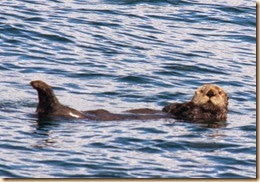 On the morning of July 6, we tied the boat to the Bartlett Cove public dock once again and said good bye to Cindee and Steve whose return flight left later that day. We headed out for the next leg of our trip, back to Sitka.
On the morning of July 6, we tied the boat to the Bartlett Cove public dock once again and said good bye to Cindee and Steve whose return flight left later that day. We headed out for the next leg of our trip, back to Sitka.
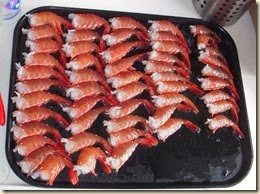 Douglas Harbor and Hoonah Sound proved to be another mixed bag. The prawn pots produced at a steady, but not extravagant pace, while the crab pots were total busts. Over our two visits to the anchorage we did 8 crab pot drops in widely varying locations and depths and not one crab showed up, legal or not.
Douglas Harbor and Hoonah Sound proved to be another mixed bag. The prawn pots produced at a steady, but not extravagant pace, while the crab pots were total busts. Over our two visits to the anchorage we did 8 crab pot drops in widely varying locations and depths and not one crab showed up, legal or not. 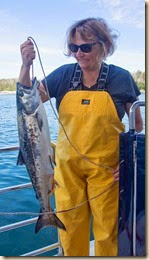 For someone impatient (Kurt), it seemed a long time. For someone patient and who has researched the topic (Marcia), it was just long enough and the call "fish on" occurred after about 1-1/2 hours. Marcia pulled the king salmon close to the boat and Kurt netted it. The tape measure came out to verify its legality at 30 inches.
For someone impatient (Kurt), it seemed a long time. For someone patient and who has researched the topic (Marcia), it was just long enough and the call "fish on" occurred after about 1-1/2 hours. Marcia pulled the king salmon close to the boat and Kurt netted it. The tape measure came out to verify its legality at 30 inches.  Both Klawock and Hydaburg have strong NW native indian heritages (Tlingit and Haida, respectively) and strive to preserve their cultures. Carving totems is part of it and each has a totem park with many recently carved totems.
Both Klawock and Hydaburg have strong NW native indian heritages (Tlingit and Haida, respectively) and strive to preserve their cultures. Carving totems is part of it and each has a totem park with many recently carved totems. 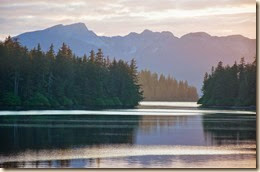 For Memorial Day weekend, we headed out for a couple of nights (we needed to be back on Monday to be prepared for our guided fishing trip on Tuesday). We tried to visit two new anchorages but ended up at a familiar one, Kaguk Cove, and one new one, Salt Lake Bay (both on Prince of Wales Island). Salt Lake Bay, despite a narrow entrance with submerged rocks guarding it, was very lovely and worth repeat visits.
For Memorial Day weekend, we headed out for a couple of nights (we needed to be back on Monday to be prepared for our guided fishing trip on Tuesday). We tried to visit two new anchorages but ended up at a familiar one, Kaguk Cove, and one new one, Salt Lake Bay (both on Prince of Wales Island). Salt Lake Bay, despite a narrow entrance with submerged rocks guarding it, was very lovely and worth repeat visits. We arrived in Craig on Wednesday, 5/21. We had good weather going around Cape Chacon but it started going downhill that afternoon as we headed up Cordova Bay.
Since we weren’t in a big hurry, we traveled only 30 – 40 miles a day and checked out three new (to us) anchorages along the way. We anchored in Max Cove (Klakas Inlet), Dunbar Inlet (Sukkwan Island) and Port San Antonio (Baker Island) before finally arriving at Craig. All three of the anchorages were very secure with good holding bottoms. We appreciated the holding because 15-20 knot winds were common in our anchorages. Fortunately, none had long fetches that built up big waves and the wind generally dropped at night anyway.
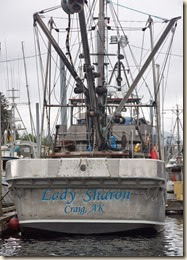 Since the neither the commercial nor the sport fishing seasons are really underway, we had our pick of spots on the transient docks at Craig. We chose to go into the north harbor since in our previous two visits, we were in the south harbor.
Since the neither the commercial nor the sport fishing seasons are really underway, we had our pick of spots on the transient docks at Craig. We chose to go into the north harbor since in our previous two visits, we were in the south harbor.
Similar to Ketchikan, we’ll be here a few days, go cruising in the local area, then return for a few more days. While here we intend to rent a car for a day and drive around Prince of Wales (PoW) Island. As it turns out, on account of past logging, PoW Island has more roads than the rest of the islands in SE Alaska combined. We’re also going to go out with a fishing guide for day of instruction and fishing.
After spending 3 days in Ketchikan, we headed out around Revillagigedo Island (where Ketchikan is located) for a 5 days. We visited our favorites at Yes Bay and Fitzgibbon Cove and also spent a night in Walker Cove in Misty Fjord National Monument. We were successful crabbing and prawning along the way but the catching was slower than our previous visits which were in June and July.

We returned on May 14 to Ketchikan where we had our outboard serviced and picked up a piece of metal work we had fabricated to improve the mounting system for the downrigger we purchased to fish from Alpenglow.
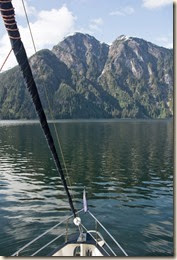 On Saturday morning, shortly before we departed, Dave & Dorothy Nagle on DavidEllis came into Bar Harbor where they'll meet their daughter and her family for a brief cruise. We had a whirlwind visit and set up a tentative rendezvous for later in the summer.
On Saturday morning, shortly before we departed, Dave & Dorothy Nagle on DavidEllis came into Bar Harbor where they'll meet their daughter and her family for a brief cruise. We had a whirlwind visit and set up a tentative rendezvous for later in the summer.
We are now anchored in Gardner Bay on Prince of Wales Island. From here we'll head around Cape Chacon and explore our way through Cordova Bay towards Craig. In Craig, we'd like to go out with a fishing guide to pick up fishing techniques and local knowledge about the Craig area.
The last post talked about our steady northward jog to Alaska and it continued all the way to Ketchikan, arriving at the Bar Harbor marina in Ketchikan in the early afternoon. From Campbell River to Ketchikan we plodded along for seven straight days averaging 11 hours of engine operation and covering an average of 72 miles a day. The only variation to the normal route was taking Principe/Petrel Channel on the west side Pitt Island rather than Grenville Channel for the last section of the “ditch”.
Mostly we saw very few vessels, commercial or pleasure. We were passed by one pleasure craft north of Cape Caution and then did not see another cruising boat until we churned up Revillagigedo Channel towards Ketchikan. Even the commercial traffic was light.
The most “excitement” we had was when we were boarded by the RCMP on the north side of Dundas Island as we were rounding the corner to go into Brundige Inlet for the evening anchor. I think they boarded us partly out of boredom because of so little vessel activity and the fact that we had not been inspected when we cleared into Canada at Montague Harbour (we had a telephone clearance number and waited at the dock for the required 15 minutes but no one showed up). A few routine questions and we received a copy of their completed inspection form for our boat book.
We’ll be here three nights then will do a short trip to some favorite anchorages around Behm Canal. We have an appointment to get the Honda outboard motor serviced at the local shop on 4/15. They are very busy right now as everyone is getting ready for the local fishing derby coming up.
Ship’s log is 120.2 hours and 761.5 miles since leaving Eagle Harbor, Bainbridge Island.
Last March, we closed on purchasing a house in the Tucson area (Executing the Plan). Marcia spent a grand total of five nights in it before closing up for the summer and returning to the PNW to get ready for the 2013 cruising season.
 Last October, we stuffed the remnants of our Seattle house, that had been stuffed into a 10’ x 10’ storage unit, into a 8’ x 16’ moving pod for shipment to our new house, 1600 miles away. About 10 days after our possessions left the area, we (Marcia, myself and the cats) followed on the first “great migration”. We arrived at our new winter homeport on Halloween and have been busy settling in to it and the area since then.
Last October, we stuffed the remnants of our Seattle house, that had been stuffed into a 10’ x 10’ storage unit, into a 8’ x 16’ moving pod for shipment to our new house, 1600 miles away. About 10 days after our possessions left the area, we (Marcia, myself and the cats) followed on the first “great migration”. We arrived at our new winter homeport on Halloween and have been busy settling in to it and the area since then.
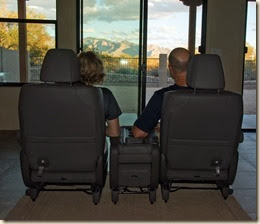 Since we kept only a few pieces of furniture, we’ve had to improvise until we’ve acquired new items. One improvisation was taking the middle row of seats from the minivan and using them as our “couch”.
Since we kept only a few pieces of furniture, we’ve had to improvise until we’ve acquired new items. One improvisation was taking the middle row of seats from the minivan and using them as our “couch”.
So far, the transition to a land based living has been easy and luxurious. Living on the boat forces us to compromise on space and resources (e.g., water and electricity) in ways we don’t in the house. The weather this winter has been exactly what we hoped for, moderate temperatures, ample sun and generally dry. We’re able to do pleasant walks directly from the house, and even better hikes a short drive away. We’ve used our bikes more now than since 2008.
While the weather is comfortable now, we know that the hot season here will return and our enthusiasm for the area will wilt. We plan on returning to the boat towards the end of March, prepare and provision the boat, then depart for our 2014 cruising toward the end of April.